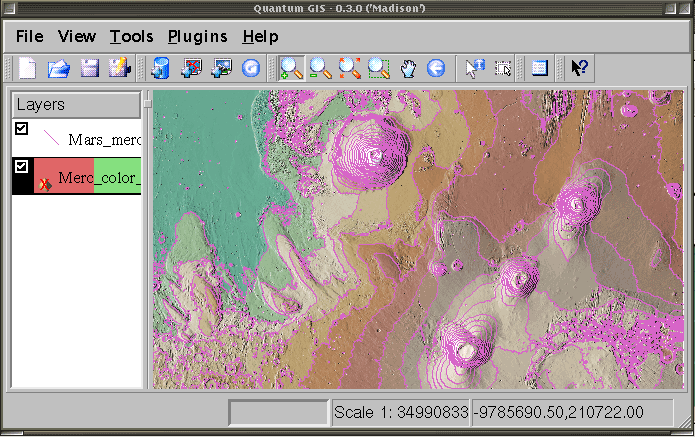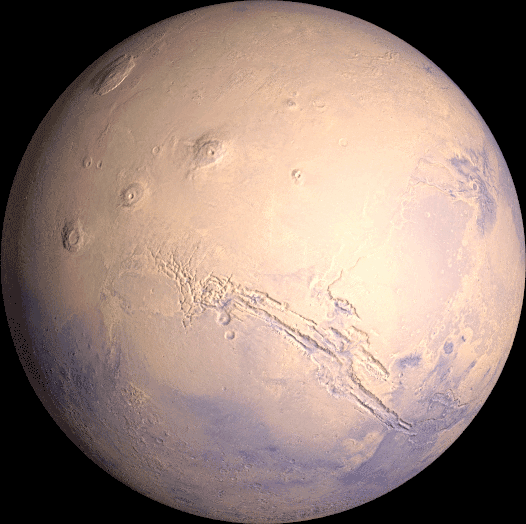Hack 34. Map Other Planets


Explore the celestial spheres (and spheroids) with standard GIS tools.
The universe is a big place, perhaps the biggest.
Kurt Vonnegut
NASA's recent missions to other planets in our solar system have had a substantial mapping component, notably the Venus Magellan and the Mars Pathfinder missions. Mars and Venus, our nearest neighbors, have the best coverage of extraterrestrial imagery and GIS data available on the Web. However, the best Solar System mapping resources on the Web don't come directly from NASA. Many promising links to older data sets now return 404 Not Found errors, and their mission homepages feature lots of media-friendly space imagery and "For Kids" sections. For the hard work of planetary cartography, NASA collaborates with the astrogeology department at the U.S. Geological Survey, http://astrogeology.usgs.gov/.
3.14.1. Making Flat Maps of Other Planets
Visit the USGS Astrogeology FTP site at ftp://ftpflag.wr.usgs.gov/dist/pigpen/ for a mother lode of other-planetary GIS data on Mars, Venus, our moon, and Jupiter's moons. The FTP site ftp://webgis.wr.usgs.gov/mars/usgs/topo/MOLA_contours_25Mscale/Mars_MOLA_contours_colorimages.zip contains a great selection of vectors and rasters for making topographical maps of Mars. Many files give instructions for ArcExplorer, but the open source GIS products featured in this book are more than apt for the task. Additionally, you can get lots of nice data from the USGS Map-A-Planet site at http://pdsmaps.wr.usgs.gov/.
Quantum GIS [Hack #64], is a great basic viewer for extraterrestrial GIS data. Figure 3-41 shows an Equirectangular projection map displayed in Quantum GIS, zoomed in to Olympus Mons and Pavonis Mons, with overlaid topographical shapefiles from the same data set.
Figure 3-41. Raster map of Mars with overlaid topo vectors

Many extraterrestrial maps available on the Web use the visually familiar technique of hypsographic tintingfeatures shaded in an attractive, earthly scheme showing lowest altitudes in marine blue, and mountain peaks in a burnt-out yellow. This coloring scheme lends Earth maps a pleasing "natural look"; seeing other planets drawn with hypsographic tints reveals the attractive illusion for what it is.
3.14.2. Rendering 3-D Imagery of Other Planets
Raster maps in cylindrical projections are also suitable for use with xplanet, the 3-D planet renderer covered in [Hack #46] . xplanet was designed for rendering images of planetary surfaces and is a really good place to get started in this area. You can find code, images, and sample configurations at http://xplanet.sf.net/. A good compendium of planetary maps available online in cylindrical projections can be found at http://www.johnstonsarchive.net/spaceart/planetcylmaps.html.
The same cylindrical projection maps are perfect for rendering planets in POV-Ray, free raytracing software [Hack #20] . Using data from the Viking missions, available at http://solarviews.com/eng/homepage.htm, we rendered a 3-D image of Mars with the following .pov file:
camera {
location <0, 0, -2.5>
look_at <.01, 0, 0>
}
light_source { <3,0,-5> color <1,1,1> }
sphere {
<0,0,0>, 1
pigment {
image_map {
jpeg "marscyl1l.jpg"
map_type 1
}
}
normal {
bump_map {
png "marscyl2.png"
map_type 1
bump_size 10
}
}
finish {
ambient 0.1
diffuse 1
specular 0.2
roughness .2
}
rotate <0,180,-25>
}
The core of this rendering is the sphere section, which provides the shape of the planet. The image_map section specifies the appearance of the surface, with the map_type of 1 causing the JPEG to be wrapped around the sphere. The bump_map section provides the elevation data, with the bump_size parameter emphasizing the terrain for visual effect. (We had to use the convert tool from ImageMagick to turn the original TIFF height field into a PNG. For reasons unknown, POV-Ray didn't care for the TIFF.) Finally, the rendering of Mars is rotated around to show the Valles Marineris and the Tharsis volcanos, and is tilted to reflect the planet's actual rotational tilt. The rendering is shown in Figure 3-42.
Figure 3-42. The Valles Marineris and the Tharsis volcanos of Mars, rendered in POV-Ray

Finally, if you're a fan of Manifold [Hack #65] , an excellent and inexpensive commercial GIS package, you'll be pleased to know that it, too, offers 3-D surfaces for all the planets in the Solar System; Mars and Earth are modeled as spheroids, and the other planetary bodies are modeled as spheres.
3.14.3. Other Otherworldly Resources
- Ralph Aeschliman's web site (http://ralphaeschliman.com/) is a delight for the planetary-mapping enthusiast. Formerly a researcher at the USGS astrogeology department, he has produced a beautiful series of handcrafted art maps of Mars, Venus, and Earth's moon based on GIS data published by the USGShighly recommended viewing.
- James Hastings-Trew maintains another nice gallery of planetary images and data sets (http://gw.marketingden.com/planets/planets.html), with an emphasis more on art than on accuracy.
- "Representing Star Fields" (http://astronomy.swin.edu.au/~pbourke/povray/starfield/) is a good tutorial on rendering star field backgrounds in POV-Ray.
- Celestia (http://celestia.sourceforge.net/) is an open source "Universe Simulator" with which you can "travel throughout the solar system, to any of over 100,000 stars, or even beyond the galaxy," with contributions from a large community of enthusiasts.
- The National Space Science Data Center (http://nssdc.gsfc.nasa.gov/planetary/) has a lot of data available on CD-ROM, particularly for Venus.
NASA's Solar System Simulator (http://maps.jpl.nasa.gov/) has a fine selection of non-GIS maps for all the bodies in our solar system that have been closely inspected.
Mapping Your Life
- Hacks 1-13
- Hack 1. Put a Map on It: Mapping Arbitrary Locations with Online Services
- Hack 2. Route Planning Online
- Hack 3. Map the Places Youve Visited
- Hack 4. Find Your House on an Aerial Photograph
- Hack 5. The Road Less Traveled by in MapQuest
- Hack 6. Make Route Maps Easier to Read
- Hack 7. Will the Kids Barf?
- Hack 8. Publish Maps of Your Photos on the Web
- Hack 9. Track the Friendly Skies with Sherlock
- Hack 10. Georeference Digital Photos
- Hack 11. How Far? How Fast? Geo-Enabling Your Spreadsheet
- Hack 12. Create a Distance Grid in Excel
- Hack 13. Add Maps to Excel Spreadsheets with MapPoint
Mapping Your Neighborhood
- Hacks 14-21
- Hack 14. Make Free Maps of the United States Online
- Hack 15. Zoom Right In on Your Neighborhood
- Hack 16. Who Are the Neighbors Voting For?
- Hack 17. Map Nearby Wi-Fi Hotspots
- Hack 18. Why You Cant Watch Broadcast TV
- Hack 19. Analyze Elevation Profiles for Wireless Community Networks
- Hack 20. Make 3-D Raytraced Terrain Models
- Hack 21. Map Health Code Violations with RDFMapper
Mapping Your World
- Hacks 22-34
- Hack 22. Digging to China
- Hack 23. Explore David Rumseys Historical Maps
- Hack 24. Explore a 3-D Model of the Entire World
- Hack 25. Work with Multiple Lat/Long Formats
- Hack 26. Work with Different Coordinate Systems
- Hack 27. Calculate the Distance Between Points on the Earths Surface
- Hack 28. Experiment with Different Cartographic Projections
- Hack 29. Plot Arbitrary Points on a World Map
- Hack 30. Plot a Great Circle on a Flat Map
- Hack 31. Plot Dymaxion Maps in Perl
- Hack 32. Hack on Base Maps in Your Favorite Image Editor
- Hack 33. Georeference an Arbitrary Tourist Map
- Hack 34. Map Other Planets
Mapping (on) the Web
- Hacks 35-46
- Hack 35. Search Local, Find Global
- Hack 36. Shorten Online Map URLs
- Hack 37. Tweak the Look and Feel of Web Maps
- Hack 38. Add Location to Weblogs and RSS Feeds
- Hack 39. View Your Photo Thumbnails on a Flash Map
- Hack 40. Plot Points on a Spinning Globe Applet
- Hack 41. Plot Points on an Interactive Map Using DHTML
- Hack 42. Map Your Tracklogs on the Web
- Hack 43. Map Earthquakes in (Nearly) Real Time
- Hack 44. Plot Statistics Against Shapes
- Hack 45. Extract a Spatial Model from Wikipedia
- Hack 46. Map Global Weather Conditions
Mapping with Gadgets
- Hacks 47-63
- How GPS Works
- Hack 47. Get Maps on Your Mobile Phone
- Hack 48. Accessorize Your GPS
- Hack 49. Get Your Tracklogs in Windows or Linux
- Hack 50. The Serial Port to USB Conundrum
- Hack 51. Speak in Geotongues: GPSBabel to the Rescue
- Hack 52. Show Your Waypoints on Aerial Photos with Terrabrowser
- Hack 53. Visualize Your Tracks in Three Dimensions
- Hack 54. Create Your Own Maps for a Garmin GPS
- Hack 55. Use Your Track Memory as a GPS Base Map
- Hack 56. Animate Your Tracklogs
- Hack 57. Connect to Your GPS from Multiple Applications
- Hack 58. Dont Lose Your Tracklogs!
- Hack 59. Geocode Your Voice Recordings and Other Media
- Hack 60. Improve the Accuracy of Your GPS with Differential GPS
- Hack 61. Build a Map of Local GSM Cells
- Hack 62. Build a Car Computer
- Hack 63. Build Your Own Car Navigation System with GpsDrive
Mapping on Your Desktop
- Hacks 64-77
- Hack 64. Mapping Local Areas of Interest with Quantum GIS
- Hack 65. Extract Data from Maps with Manifold
- Hack 66. Java-Based Desktop Mapping with Openmap
- Hack 67. Seamless Data Download from the USGS
- Hack 68. Convert Geospatial Data Between Different Formats
- Hack 69. Find Your Way Around GRASS
- Hack 70. Import Your GPS Waypoints and Tracklogs into GRASS
- Hack 71. Turn Your Tracklogs into ESRI Shapefiles
- Hack 72. Add Relief to Your Topographic Maps
- Hack 73. Make Your Own Contour Maps
- Hack 74. Plot Wireless Network Viewsheds with GRASS
- Hack 75. Share Your GRASS Maps with the World
- Hack 76. Explore the Effects of Global Warming
- Conclusion
- Hack 77. Become a GRASS Ninja
Names and Places
- Hacks 78-86
- Hack 78. What to Do if Your Government Is Hoarding Geographic Data
- Hack 79. Geocode a U.S. Street Address
- Hack 80. Automatically Geocode U.S. Addresses
- Hack 81. Clean Up U.S. Addresses
- Hack 82. Find Nearby Things Using U.S. ZIP Codes
- Hack 83. Map Numerical Data the Easy Way
- Hack 84. Build a Free World Gazetteer
- Hack 85. Geocode U.S. Locations with the GNIS
- Hack 86. Track a Package Across the U.S.
Building the Geospatial Web
- Hacks 87-92
- Hack 87. Build a Spatially Indexed Data Store
- Hack 88. Load Your Waypoints into a Spatial Database
- Hack 89. Publish Your Geodata to the Web with GeoServer
- Hack 90. Crawl the Geospatial Web with RedSpider
- Hack 91. Build Interactive Web-Based Map Applications
- Hack 92. Map Wardriving (and other!) Data with MapServer
Mapping with Other People
- Hacks 93-100
- Hack 93. Node Runner
- Hack 94. Geo-Warchalking with 2-D Barcodes
- Hack 95. Model Interactive Spaces
- Hack 96. Share Geo-Photos on the Web
- Hack 97. Set Up an OpenGuide for Your Hometown
- Hack 98. Give Your Great-Great-Grandfather a GPS
- Hack 99. Map Your Friend-of-a-Friend Network
- Hack 100. Map Imaginary Places
EAN: 2147483647
Pages: 172
